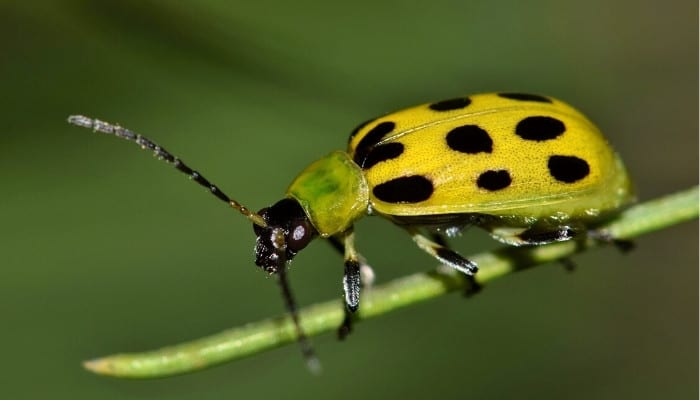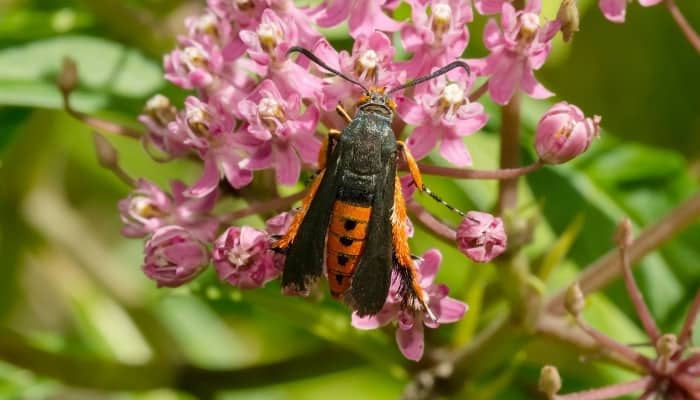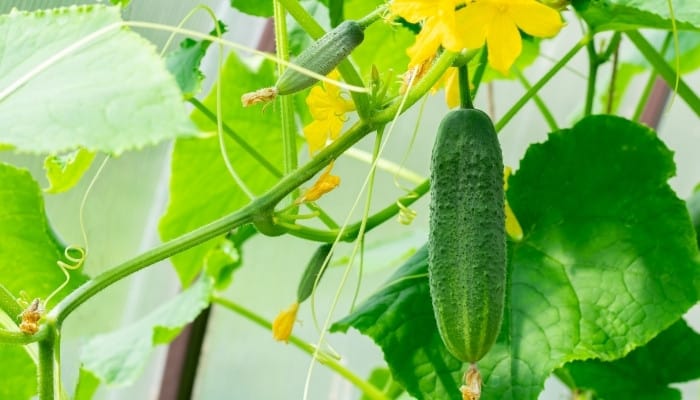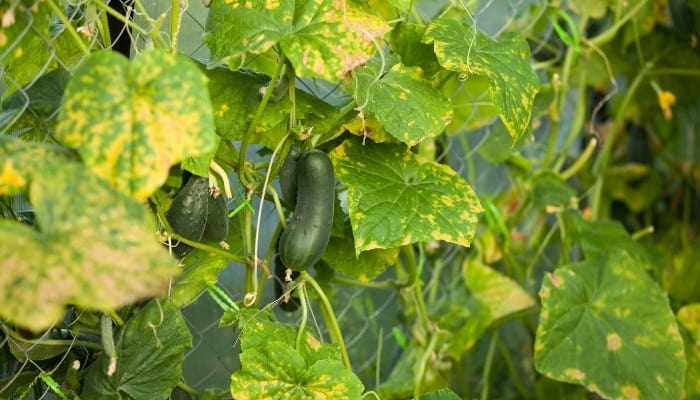If the Indian Lemon cucumber plant is not being cultivated, the presence of a yellow pigment on a regular green cucumber will not be desirable.
These squash plants can start displaying pale green foliage that gradually yellows due to damage from pests, disease, and poor care – so early detection is key if you want to harvest crisp, healthy cukes.
How do you fix yellow cucumber leaves? Yellow cucumber leaves can be fixed by ensuring your plant receives enough nutrients with the aid of nitrogen-rich fertilizer and high-quality organic compost. At least eight hours of sunlight and a consistent watering schedule will further prevent chlorophyll loss in the leaves.
Maintaining good basic care in terms of light, water and feed should give your cucumber plant a fighting chance against leaf discoloration, but don’t underestimate the importance of disease and pest-control measures.
In the following guide, we’ll break down each of the possible causes behind yellowing leaves, plus provide pro tips and FAQs on cucumber growth.
Reasons Cucumber Leaves Turn Yellow & How To Fix It
Cucumber leaves become yellow due to many factors which are largely in your control.
From improper watering and pest infestations to nutrient imbalances in the soil and more, we’ve pinpointed six common causes of yellowing, their symptoms, and the pro tips on how to correct them.
Possible Cause #1 – Watering Issues
The health of your cucumber plant will suffer from being under or overwatered – the former mistake produces brown leaves whereas yellowing points to overwatering.
The stress of this excess moisture suffocates the plant roots, removing oxygen from the soil and much of the foliage’s vigor and color.
What Does an Overwatered Cucumber Plant Look Like?
The cucumber fruit itself may have sunken brown or dark water spots and may appear cracked in places due to tears in the expanding surface tissue.
Whole leaves can also appear uniform pale green and yellow.
Common Signs
- Yellowing or pale green foliage
- Limp, droopy leaves
- Leaves feel softer to the touch
Solution
Only water the plant base once weekly in your garden (or once daily if growing in a greenhouse), checking with your finger up to the first knuckle that the first 1-2 inches of the soil bed is moist but not waterlogged.
If it’s not your watering technique, then heavy, low-quality soil could be letting you down.
Master gardener and founder of Outdoor Happens Elle Meager recommends using:
“High-end compost rich in organic matter to help the soil drain and prevent water from accumulating at the roots.”
Possible Cause #2 – Nutrient Deficiency
Cucumber plants are heavy nutrient feeders, requiring higher levels of nitrogen, magnesium, and potassium than most to produce full growth.
When the soil has a low nutrient content, the cucumber fruit grows small and thin while new leaves will appear stunted and older bottom leaves will turn yellow and drop off.
What Nutrient Deficiency Causes Yellow Leaves?
A nitrogen deficiency will cause yellowing in the foliage since the green pigment (chlorophyll) cannot be produced without it, and nitrogen is, unfortunately, one nutrient that washes away too easily in the soil.
Common Signs
- Yellow leaves at bottom
- Pale green foliage on entire plant
- Slow or stunted growth
Solution
Look for a commercial fertilizer with a high NPK ratio (25:15:15 nitrogen, phosphorous, and potassium) to correct nutrient loss.
Alternatively, you can prevent nitrogen depletion with slow-release organic methods.
Heather Rhoades of Gardening Know How recommends “using composted manure or adding coffee grounds to the soil.”
If your soil shows to be lacking in magnesium after testing (try this complete analysis kit), this can also contribute to yellowing deep between the leaf veins which can spread.
Apply an Epsom salt (magnesium sulfate) spray solution either directly onto the leaves or in the soil.
Possible Cause #3 – Lighting Issues
Cucumbers count on their plant leaves to act as solar panels and convert energy into the glucose that helps them to grow.
When sunlight levels are inadequate, the fruit starves and the leaves fail to produce enough chlorophyll, turning yellow.
How Many Hours of Sun Does a Cucumber Need?
Cucumber plants need at least six hours of full sunlight to thrive, though eight hours is ideal for producing a high yield.
Common Signs
- Pale green-yellow leaves
- Stunted fruit growth
- Pale green vines
Solution
If you’re growing your cucumbers in pots or containers, move them to a spot where they’ll receive a minimum of six hours of direct sunlight, and provide your greenhouse cukes with supplemental lighting during winter.
If you’re growing your cucumbers with the aid of LED or fluorescent lighting, Horticulturist Jessica Westover advises placing them in a minimum of 12 hours light to equal the sun’s strength.
“Run them during natural daylight hours and turn them off once it gets dark, ensuring the foliage is 4-8 inches below the lights.”
Possible Cause #4 – Pests
Bugs can cause leaf discoloration either by feeding off the foliage surface or burrowing their way into the stem, thus weakening the leaves’ ability to take in nutrients.
Let’s look at two common cucumber pests:
Striped/Spotted Cucumber Beetles

Common Signs
- Slender black/yellow striped or black/yellow spotted beetles on roots
- Holes on foliage
- Wilting leaves
Solution
Editor of The Old Farmer’s Almanac Janice Stillman recommends “picking them off with bright gloves covered in petroleum jelly” as they’re hard to remove.
“Also, put protective row covers or fine netting over the seedlings straight after planting and put sticky traps in place once the covers come off in mid-summer.”
Squash Vine Borers

Common Signs
- Orange/black moth (adult), white wrinkled maggot (larvae) on plant
- Wilting leaves
- Holes or tears at base of stem
Solution
Cover the saplings in protective netting to deter adult vine borers.
Once the plant has developed 2-3 sets of leaves, Jessica Walliser at Savvy Gardening advises preventing further damage caused by their larvae:
“Wrap the plant base in a strip of aluminum foil to prevent vine borer egg-laying and replace it every 2 weeks.”
Possible Cause #5 – Bacterial & Fungal Diseases
If cucumber plants are grown in overly humid, saturated, or crowded conditions, this can be ripe for bacterial and fungal infections to take hold.
Fortunately, there are now many disease-resistant varieties to pick from, but it’s good to recognize the following blights:
Cucumber Mosaic Virus
Common Signs
- Light green/yellow mosaic-like mottling on leaves
- Wrinkled, misshapen cucumber fruit
- Distorted, curling new leaves
Solution
Prevent spread by pruning infected leaves immediately, or discard the plant altogether if the fruit has been affected.
While there is no known cure, vegetable crop pathologist at Cornell University Thomas A. Zitter advises that the virus transmission (which is commonly spread by aphids) can be “prevented by using a Remay floating row cover during aphid migration season.”
Powdery Mildew
Common Signs
- White powdery spots on foliage and stems
- Pale yellow spots on leaves
Solution
Avoid overhead watering and improve air circulation by pruning back leaves or weeds near the base to prevent crowded foliage.
Also, in the fall, ensure any dead or diseased leaves or fruit remnants have been removed following the end of the growing season.
Possible Cause #6 – Natural Plant & Leaf Aging
As they reach their overripe stage, cucumber plants will naturally become yellow as their cells age and the green chlorophyll pigment fades from pale green to a uniform yellow color.
This eventually affects the entire plant itself as well as the leaves:
Chlorophyll Fade on Fruit
Common Signs
- Pale green-yellowing cucumbers
- Soft or bulbous-shaped fruit
Solution
Quite simply, cucumbers need to be checked regularly for ripeness and should be harvested as soon as they feel firm to the touch, are relatively slim, and have an evenly green appearance.
On average, cucumber varieties can be ready for picking between 40-70 days after planting, so keep an eye on their progress around the 5-week mark.
Pale Green Leaves
Common Signs
- Very light green-yellow leaves
- Blooms may also be curled and yellowing
Solution
If the yellowing leaves are accompanied by a faded fruit then your plant is overripe and unfit for consumption, but if the leaves are discoloring independently, your plant can still be saved.
Prune especially pale green leaves using sterilized pruning shears to prevent disease spread and adhere to the aforementioned care tips that relate to entire yellowing or pale green (not mottling or spots) on the leaves.
This could mean reviewing your watering routine, testing the soil’s nutrient content, or growing your cukes in the appropriate amount of light.
Cucumber Growing Tips & Common Questions

When To Plant Cucumbers
As warm-season crops, cucumbers should be planted outdoors no later than two weeks after the last frost date.
This is typically between April-June or early February in very hot climates and heated greenhouses. Soil and air temperatures should remain predictably above 65°F (18°C).
Cucumber Companion Plants
Cucumbers will grow well alongside legumes, broccoli, peas, onions, cabbage, cauliflower, lettuce, corn, and radishes.
The root systems of legumes in particular releases nitrates into the surrounding soil, benefiting cucumber plants from the increase in atmospheric nitrogen.
How Long Do Cucumbers Take To Grow?
From planting to harvest, cucumbers can take between 6-10 weeks to ripen. Growing time depends on the specific variety, soil medium, fertilizer use, and temperature.
They are commonly harvested when they measure between 2 and 8 inches depending on whether they are grown as pickles or slicers.
Ideal Fertilizer for Cucumbers
Botanist and author of Vegetable Growing: Month-by-month John Harrison recommends a:
“High-nitrogen content soluble fertilizer such as Chempak which contains all the trace elements of nutrients to get young leaves and stems off to a great start.”
For an organic alternative, Harrison heartily advocates brewing a stinging nettle tea:
“Steep nettles in water for 3-6 weeks and use the solution as a foliar spray – this is packed with vitamins and gives your cucumber plant an immunity boost to provide greater pest defense!”
How Often To Water Cucumber Plants
Garden-grown cucumber plants should receive at least 1-2 inches of water once weekly and will need daily watering in greenhouses.
Twice weekly watering can be required during particularly high mid-summer temperatures.
Irregular watering can lead to bitter fruit, so be sure to check regularly with your finger that the first few inches of soil are dry and ready for watering, as opposed to moist.
Can Cucumbers Be Grown in Containers?
Yes, cucumbers can be grown in pots or containers. Opt for bushy varieties well adapted to potted growth such as salad or pickle bush cucumbers and use peat-free multi-purpose compost.
Pots should be placed in a temperature range of 70-75°F (21-24°C) and will need a stake or trellis system to support the vines as they develop.
Should Yellow Cucumber Leaves Be Removed?
If the yellowing on the foliage is consistent with the symptoms of plant disease (i.e. mosaic-like yellow, pale green mottling, or white spots), then any affected leaves should be removed immediately to prevent bacterial spread.
If all the leaves on your cucumber plant are evenly yellow or very pale green, only prune back those worst affected.
Should I Pick the Flowers Off My Cucumber Plants?
Cucumber plants produce male flowers (to pollinate the fruit) and female flowers (producing the fruit), but often too many blooms are produced in good growing conditions and overcrowd the plant.
In this case, you should pinch off or prune these yellow blossoms to improve leaf growth, removing ones at the bottom of the plant so that more energy goes into growing the top cucumbers.
What Does It Mean When a Cucumber Turns Yellow?
When cucumber fruit itself turns yellow, this usually means that it is overripe and has been left to mature on the vine past the point of consumption, particularly if it has grown bulbous.
Yellow cucumbers that have grown small and misshapen may have succumbed to the mosaic virus or have a severe nitrogen deficiency.
How Long Will Cucumber Plants Produce?
Small cucumber plant varieties grown for pickling will ripen fairly quickly and reach peak production at around 40 days, whereas longer-length slicing cucumber varieties may produce for 50 days or more.
Compact bushy varieties grown in pots tend to produce their fruit all at once within 40-50 days.
Can You Grow Cucumbers All Year Round?
As long as they have adequate frost protection during winter, you can enjoy a limitless harvest with cucumbers either grown in the garden or indoor pots and greenhouses.
For the majority of growers living outside the warmest U.S. zones (Florida, California, and Hawaii), potted bush varieties of cucumbers are recommended for successful winter growth.
Wrapping It Up
In summary, your cucumber plant can sport yellow leaves when growing conditions are far from ideal (overwatered, poorly lit, or nutrient-deficient soil), but they can also be the work of pest infestations and disease, so good air circulation and regular pest control measures are key.
As yellowing foliage is also a natural sign of aging, your fast-growing cucumbers need to be harvested promptly to ensure green crisp-quality cucumber fruit every time.
Sources:
https://www.growingreenhouse.com/why-are-greenhouse-cucumbers-wilting-and-dying/
https://www.gardeningknowhow.com/edible/vegetables/cucumber/cucumber-plant-companions.htm
https://www.urbanorganicyield.com/epsom-salt-for-cucumbers/
https://www.youtube.com/watch?v=g8PbSxg6yVo
https://www.gardeningknowhow.com/edible/vegetables/cucumber/cracking-in-cucumbers.htm
https://www.growingproduce.com/vegetables/what-it-takes-to-conquer-cucumber-mosaic-virus/
https://www.gardeningknowhow.com/garden-how-to/soil-fertilizers/nitrogen-plant-fertilizer.htm
http://www.gardening.cornell.edu/homegardening/scenef65b.html
https://www.apsnet.org/edcenter/disandpath/viral/pdlessons/Pages/Cucumbermosaic.aspx
https://savvygardening.com/how-to-prevent-squash-vine-borers-organically/
https://www.almanac.com/pest/squash-vine-borer
https://www.greatlittlegarden.co.uk/blog/post/meet-john-harrison-of-the-allotment-garden
https://www.almanac.com/plant/cucumbers
https://www.gardenerscorner.co.uk/threads/yellow-spots-on-cucumber-leaves.15871/

